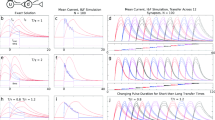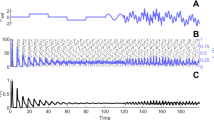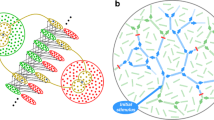Abstract
When a population spike (pulse-packet) propagates through a feedforward network with random excitatory connections, it either evolves to a sustained stable level of synchronous activity or fades away (Diesmann et al. in Nature 402:529–533 1999; Cateau and Fukai Neur Netw 14:675–685 2001). Here I demonstrate that in the presence of noise, the probability of the survival of the pulse-packet (or, equivalently, the firing rate of output neurons) reflects the intensity of the input. Furthermore, inhibitory coupling between layers can result in quasi- periodic alternation between several levels of firing activity. These results are obtained by analyzing the evolution of pulse-packet activity as a Markov chain. For the Markov chain analysis, the output of the chain is a linear mapping of the input into a lower-dimensional space, and the eigenvalues and eigenvectors of the transition matrix determine the dynamics of the evolution. Synchronous propagation of firing activity in successive pools of neurons are simulated in networks of integrate-and-fire and compartmental model neurons, and, consistent with the discrete Markov process, the activation of each pool is observed to be predominantly dependent upon the number of cells that fired in the previous pool. Simulation results agree with the numerical solutions of the Markov model. When inhibitory coupling between layers are included in the Markov model, some eigenvalues become complex numbers, implying oscillatory dynamics. The quasiperiodic dynamics is validated with simulation with leaky integrate-and-fire neurons. The networks demonstrate different modes of quasiperiodic activity as the inhibition or excitation parameters of the network are varied.
Similar content being viewed by others
References
Abeles M (1991) Corticonics: neuronal circutes of cerebral cortex. Cambridge University Press, Cambridge, UK
Aihara K, Matsumoto G (1986) Chaotic oscillation and bifurcation in squid giant axons. In: Holden AV (ed) Chaos. Manchester University Press, Manchester, UK, pp 257–269
Anderson JS, Lampl I, Gillespie DC, Ferster D (2000) The contribution of noise to contrast invariance of orientation tuning in cat visual cortex. Science 290:1968–1972
Aviel Y, Pavlov E, Abeles M, Horn D (2002) Synfire chain in a balanced network. Neurocomputing 44:285–292
Babloyantz A, Lourenco C (1994) Computation with chaos: a paradigm for cortical activity. Proc Natl Acad Sci USA 91:9027–9031
Basar E (ed) (1990) Chaos in brain function. Springer, Berlin Heidelberg New York
Calvin WH, Stevens CF (1968) Synaptic noise and other sources of randomness in motoneuron interspike intervals. J Neurophysiol 31:574–587
Cateau H, Fukai T (2001) Fokker-Planck approach to the pulse packet propagation in synfire chain. Neural Netw 14:675–685
Date A, Bienenstock E, Geman S (1998) On the temporal resolution of neural activity. Technical Report, Division of Applied Mathematics, Brown University, Providence, RI. http://www.dam.brown.edu/people/elie/papers/temp_res.ps
Destexhe A, Mainen ZF, Sejnowski TJ (1994) An efficient method for computing synaptic conductances based on a kinetic model of receptor binding. Neural Comput 6:10–14
Destexhe A, Pare D (1999) Impact of network activity on the integrative properties of neocortical pyramidal neurons in vivo. J Neurophysiol 81:1531–1547
Diesmann M, Gewaltig MO, Aertsen A (1999) Stable propagation of synchronous spiking in cortical neural networks. Nature 402:529–533
Engel AK, Fries P, Singer W (2001) Dynamic predictions: oscillations and synchrony in top-down processing. Nat Rev Neurosci 2:704–716
Freeman WJ (1987) Simulation of chaotic EEG patterns with a dynamic model of olfactory system. Biol Cybern 56:139:150
Freeman WJ (2000) A proposed name for aperiodic brain activity: stochastic chaos. Neural Netw 13:11–13
Gewaltig MO, Diesmann M, Aertsen A (2001) Propagation of cortical synfire activity: survival probability in single trials and stability in the mean. Neural Netw 14:657–673
Gray CM, Konig P, Engel AK, Singer W (1989) Oscillatory responses in cat visual cortex exhibit inter-columnar synchronization which reflects global stimulus properties. Nature 338:334–337
Hansel D, Sompolinsky H (1992) Synchronization and computation in chaotic neural network. Phys Rev Lett 68:718–721
Hansel D, Van Vreeswijk C (2002) How noise contributes to contrast invariance of orientation tuning in cat visual cortex. J Neurosci 22:5118–5128
Herrmann M, Hertz JA, Prügel-Bennett A (1995) Analysis of synfire chain networks. Netw Comput Neural Syst 6:403–414
Hertz JA, Prügel-Bennett A (1996) Learning synfire chains: turning noise into signal. Int J Neural Syst 7:445–450
Hines M (1994) The NEURON simulation program. In: Skrzypek J (ed) Neural network simulation environments. Kluwer, Norwell, MA, pp 147–163
Holt GR, Softky WR, Koch C, Douglas RJ (1996) Comparison of discharge variability in vitro and in vivo in cat visual cortex neurons. J Neurophysiol 75:1806–1814
Litvak V, Sompolinsky H, Segev I, Abeles M (2000) On the transmission of rate code in long feed-forward networks with excitatory-inhibitory balance. In: Computational neuroscience meeting, Brugge, 16–20 July 2000
Mainen ZF, Sejnowski TJ (1995) Reliability of spike timing in neocortical neurons. Science 268:1503–1506
Markov AA (1907) Investigation of a noteworthy case of dependent trials. Izv Ros Akad Nauk 1:61–80
Maršálek P, Koch C, Maunsell J (1996) On the relationship between synaptic input and spike output jitter in individual neurons. Proc Natl Acad Sci USA 94:735–740
Meyer D (1994) Sensitivity of the stationary distribution of a Markov chain. SIAM J Matrix Anal Appl 15:715–728
Miller JP (1994) Neural coding. Neurons cleverer than we thought? Curr Biol 4:818–820
Miller R (1996) Cortico-thalamic interplay and the security of operation of neural assemblies and temporal chains in the cerebral cortex. Biol Cybern 73:129–137
Prut Y, Vaadia E, Bergman H, Haalman I, Slovin H, Abeles M (1998) Spatiotemporal structure of cortical activity: properties and behavioral relevance. J Neurophysiol 79:2857–2874
Salinas E, Sejnowski TJ (2001) Correlated neuronal activity and the flow of neural information. Nat Rev Neurosci 2:539–550
Shadlen MN, Newsome WT (1998) The variable discharge of cortical neurons: implications for connectivity, computation, and information coding. J Neurosci 18:3870–3896
Sompolinsky H, Crisanti A, Sommers HJ (1988) Chaos in random neural networks. Phys Rev Lett 61:259–262
Tsuda I (1992) Dynamic link of memory – chaotic memory map in nonequilibrium neural networks. Neural Netw 5:313–326
van Rossum MC, Turrigiano GG, Nelson SB (2002) Fast propagation of firing rates through layered networks of noisy neurons. J Neurosci 22:1956–1966
van Vreeswijk C, Sompolinsky H (1998) Chaotic balanced state in a model of cortical circuits. Neural Comput 15:1321–1371
Varela F, Lachaux JP, Rodriguez E, Martinerie J (2001) The brainweb: phase synchronization and large-scale integration. Nat Rev Neurosci 2:229–239
Yazdanbakhsh A, Babadi B, Rouhani S, Arabzadeh E, Abbasian A (2002) New attractor states for synchronous activity in synfire chains with inhibitory and excitatory coupling. Biol Cybern 86:367–378
Author information
Authors and Affiliations
Corresponding author
Additional information
Acknowledgements The author wishes to thank S. Rohani, A. Abbasian, V. Jayaraman, P. Wilken, and especially E. Winfree for their revision of the manuscript and constructive comments.
Rights and permissions
About this article
Cite this article
Moradi, F. Information coding and oscillatory activity in synfire neural networks with and without inhibitory coupling. Biol. Cybern. 91, 283–294 (2004). https://doi.org/10.1007/s00422-004-0499-x
Received:
Accepted:
Published:
Issue Date:
DOI: https://doi.org/10.1007/s00422-004-0499-x




